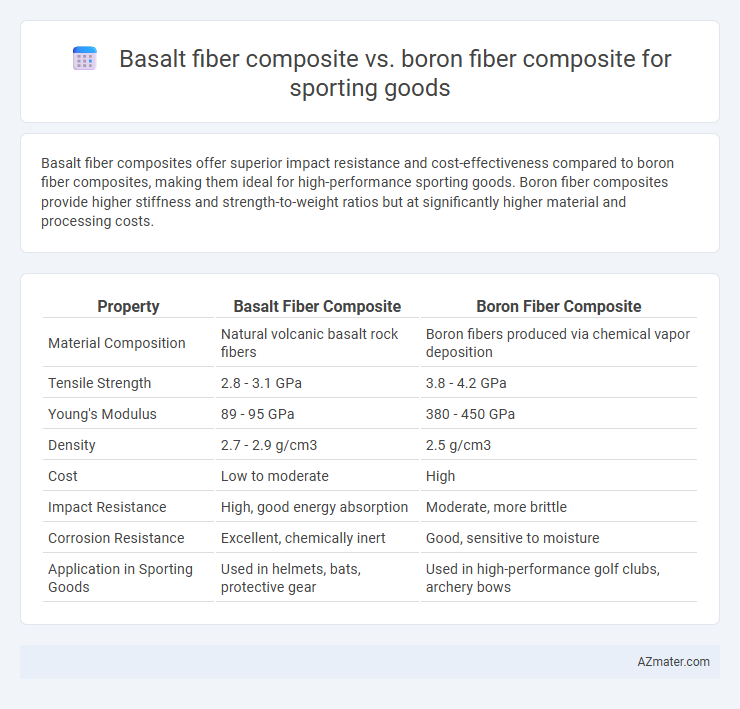Basalt fiber composites offer superior impact resistance and cost-effectiveness compared to boron fiber composites, making them ideal for high-performance sporting goods. Boron fiber composites provide higher stiffness and strength-to-weight ratios but at significantly higher material and processing costs.
Table of Comparison
| Property | Basalt Fiber Composite | Boron Fiber Composite |
|---|---|---|
| Material Composition | Natural volcanic basalt rock fibers | Boron fibers produced via chemical vapor deposition |
| Tensile Strength | 2.8 - 3.1 GPa | 3.8 - 4.2 GPa |
| Young's Modulus | 89 - 95 GPa | 380 - 450 GPa |
| Density | 2.7 - 2.9 g/cm3 | 2.5 g/cm3 |
| Cost | Low to moderate | High |
| Impact Resistance | High, good energy absorption | Moderate, more brittle |
| Corrosion Resistance | Excellent, chemically inert | Good, sensitive to moisture |
| Application in Sporting Goods | Used in helmets, bats, protective gear | Used in high-performance golf clubs, archery bows |
Introduction to Composite Fibers in Sporting Goods
Basalt fiber composite offers enhanced durability and impact resistance, making it ideal for high-performance sporting goods such as tennis rackets and fishing rods. Boron fiber composite provides exceptional stiffness and strength, commonly used in applications requiring precise control and lightweight materials like golf club shafts. Both composites improve the mechanical properties and longevity of sporting equipment by integrating advanced fiber technologies with polymer matrices.
Overview of Basalt Fiber Composite
Basalt fiber composite offers excellent tensile strength, corrosion resistance, and cost-effectiveness, making it a popular choice in sporting goods manufacturing. It provides superior vibration dampening and impact resistance compared to traditional fiberglass, enhancing performance and durability in equipment like tennis rackets and bicycle frames. The eco-friendly nature of basalt fiber, derived from volcanic rock, also appeals to environmentally conscious consumers and manufacturers in the sports industry.
Overview of Boron Fiber Composite
Boron fiber composites are renowned for their exceptional stiffness, high tensile strength, and outstanding fatigue resistance, making them ideal for high-performance sporting goods such as golf clubs, tennis rackets, and bicycle frames. These composites offer superior vibration damping and dimensional stability compared to basalt fiber composites, enhancing the precision and durability of sporting equipment. Despite higher costs, boron fiber composites provide significant advantages in weight reduction and performance, which are critical in competitive sports applications.
Mechanical Properties Comparison
Basalt fiber composites exhibit high tensile strength ranging from 2.8 to 3.1 GPa and excellent impact resistance, making them suitable for durable sporting goods. Boron fiber composites offer superior stiffness with a modulus between 400 and 450 GPa and exceptional fatigue resistance, ideal for high-performance applications requiring rigidity. While basalt fibers provide better energy absorption and cost efficiency, boron fibers dominate in stiffness and lightweight strength for advanced sporting equipment.
Weight and Density Considerations
Basalt fiber composites offer a lower density of approximately 2.6-2.8 g/cm3 compared to boron fiber composites, which typically have a density around 2.6-2.7 g/cm3, making basalt slightly heavier but generally more cost-effective for sporting goods applications. Boron fiber composites provide higher specific strength and stiffness, enabling lighter overall structures despite similar density values. Weight-sensitive sports equipment benefits from boron's superior stiffness-to-weight ratio, while basalt composites contribute enhanced impact resistance with modest weight penalties.
Durability and Impact Resistance
Basalt fiber composites offer exceptional durability and superior impact resistance due to their high tensile strength and excellent energy absorption characteristics, making them ideal for high-stress sporting goods applications. Boron fiber composites provide outstanding stiffness and strength but tend to be more brittle, which can reduce impact resistance in dynamic sports environments. The enhanced toughness of basalt fiber composites translates to longer-lasting gear with improved performance under repeated impacts.
Cost and Production Efficiency
Basalt fiber composites offer a cost-effective alternative to boron fiber composites, as basalt fibers are derived from abundant volcanic rock, reducing raw material expenses and enabling scalable production. Boron fiber composites, while providing superior stiffness and high tensile strength, involve complex manufacturing processes that increase production time and labor costs. The lower material and production costs of basalt fiber composites make them more suitable for sporting goods applications requiring high volume and cost-sensitive manufacturing.
Environmental Sustainability Analysis
Basalt fiber composites offer superior environmental sustainability compared to boron fiber composites due to their lower energy consumption and reduced carbon footprint during production, as basalt fibers are derived from abundant natural volcanic rock with minimal chemical processing. Boron fiber composites involve energy-intensive manufacturing and use scarce, non-renewable raw materials, leading to higher ecological impact and difficulties in recycling. Sporting goods made from basalt fiber composites demonstrate enhanced eco-friendliness by balancing performance with biodegradable end-of-life options and lower environmental toxicity.
Performance in Specific Sporting Applications
Basalt fiber composites offer excellent vibration damping and impact resistance, making them ideal for sports equipment like bicycle frames and tennis rackets that require shock absorption and durability. Boron fiber composites, known for their superior stiffness and high tensile strength, excel in applications such as golf club shafts and archery bows where precision and energy transfer are critical. The choice between basalt and boron fiber composites depends on the specific performance demands of the sporting good, with basalt prioritizing resilience and boron optimizing strength-to-weight ratios.
Conclusion: Choosing the Right Composite for Sports Equipment
Basalt fiber composites offer excellent impact resistance and cost-effectiveness, making them ideal for sporting goods requiring durability and flexibility, such as protective gear and paddles. Boron fiber composites provide superior stiffness and lightweight strength, best suited for high-performance applications like golf clubs and bicycle frames where precision and responsiveness are critical. Selecting the right composite depends on balancing performance requirements, budget constraints, and specific sport demands to maximize equipment efficiency and athlete safety.

Infographic: Basalt fiber composite vs Boron fiber composite for Sporting goods
 azmater.com
azmater.com